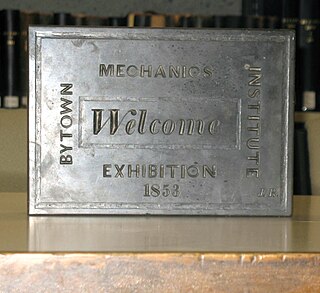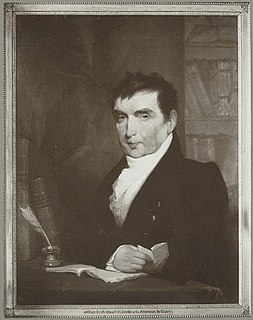
Brasenose College (BNC) is one of the constituent colleges of the University of Oxford in the United Kingdom. It began as Brasenose Hall in the 13th century, before being founded as a college in 1509. The library and chapel were added in the mid-17th century and the new quadrangle in the late 19th and early 20th centuries.

A gentlemen's club is a private social club of a type originally set up by men from Britain's upper classes in the 18th and succeeding centuries.

The Boston Athenaeum is one of the oldest independent libraries in the United States. It is also one of a number of membership libraries, for which patrons pay a yearly subscription fee to use Athenaeum services. The institution was founded in 1807 by the Anthology Club of Boston, Massachusetts. It is located at 10 1/2 Beacon Street on Beacon Hill.

The Lyceum is a Neoclassical Grade II* listed building located on Bold Street, Liverpool. It was constructed in 1802 as a news-room and England's first subscription library (1758-1942) and later became a gentleman's club. After the club relocated in 1952 the building was left unoccupied for many years, eventually falling into a state of disrepair. Calls were made for its demolition in the late 1970s, sparking a campaign to save the building. It reopened as a post office, and then a branch of the Co-operative Bank. As of November 2019, its tenant is a Chinese restaurant.

The Portico Library, The Portico or Portico Library and Gallery on Mosley Street, Manchester, is an independent subscription library designed in the Greek Revival style by Thomas Harrison of Chester and built between 1802 and 1806. It is recorded in the National Heritage List for England as a Grade II* listed building, having been designated on 25 February 1952, and has been described as "the most refined little building in Manchester".

Thomas Harrison was an English architect and bridge engineer who trained in Rome, where he studied classical architecture. Returning to England, he won the competition in 1782 for the design of Skerton Bridge in Lancaster. After moving to Lancaster he worked on local buildings, received commissions for further bridges, and designed country houses in Scotland. In 1786 Harrison was asked to design new buildings within the grounds of Lancaster and Chester castles, projects that occupied him, together with other works, until 1815. On both sites he created accommodation for prisoners, law courts, and a shire hall, while working on various other public buildings, gentlemen's clubs, churches, houses, and monuments elsewhere. His final major commission was for the design of Grosvenor Bridge in Chester.

A subscription library is a library that is financed by private funds either from membership fees or endowments. Unlike a public library, access is often restricted to members, but access rights can also be given to non-members, such as students.

Portland Public Library is the main library of the public library system in Portland, Maine, USA. It is located at 5 Monument Square on Congress Street in the Old Port neighborhood of Portland. The library has three neighborhood branches, Burbank branch, Peaks Island branch, and Riverton branch.

The London Institution was an educational institution founded in London in 1806. It preceded the University of London in making scientific education widely available in the capital to people such as the Dissenters who adhered to non-orthodox religious beliefs and were consequently barred from attending Oxford University or Cambridge University.

The Providence Athenaeum is an independent, member-supported subscription library in Providence, Rhode Island. The building is open to the public, but only members can check out items from the collection.

The Limerick Athenaeum was a centre of learning, established in Limerick city, Ireland, in 1852.

Wavertree Botanic Garden and Park is a mid-19th century public park in Liverpool, England. Originally constructed as a private botanic garden, it was taken over by Liverpool Corporation in 1846 and expanded into a public park.
Edward Edwards (1812–1886) was a British librarian, library historian, and biographer. He was an important figure in the establishment of free libraries in the United Kingdom. He died and is buried in Niton on the Isle of Wight.

The Athenaeum is a private members' club in London, founded in 1824. It is primarily a club for men and women with intellectual interests, and particularly for those who have attained some distinction in science, engineering, literature or the arts. Humphry Davy and Michael Faraday were the first chairman and secretary and 51 Nobel Laureates have been members.

The Portsmouth Athenæum is an independent membership library, gallery, and museum in Portsmouth, New Hampshire, United States. It preserves and provides access to an extensive collection of manuscripts, rare books, photographs, artworks and artifacts, and digital collections related to local history and genealogy, in addition to a circulating library for its membership. As an intellectual center of the community, it sponsors exhibitions, concerts, lectures, and other educational and cultural programs. The building, dating to 1805, has been listed on the National Register of Historic Places since 1973.

The Bytown Mechanics' Institute is an Upper Canada example of a knowledge transfer organization aimed at encouraging grassroots participation. These institutions were Victorian and moralistic in tone and class-oriented in structure which, in part, explains their failure. However, they show the tendency towards democratic institutions in the early history of Canada where the border between the United States and Canada was more fluid than in the present era and encourage such ideals. These institutions attempted to include the working class, French Canadians and women, where the British social model did not support these inclusions. The composition of the executive of the Bytown Mechanics' Institute in its various formations illustrates this and exemplifies the issues of cost and available leisure time that would eventually cause the institute's failure.

The Athenaeum in Princess Street Manchester, England, now part of Manchester Art Gallery, was originally a club built for the Manchester Athenaeum, a society for the "advancement and diffusion of knowledge", in 1837. The society, founded in 1835, met in the adjacent Royal Manchester Institution until funds had been raised for the building. The society survived financial difficulties to become the centre for Manchester's literary life. It ceased operations in 1938.

The National Club is a private club founded in 1874 for business professionals located in the Financial District of Downtown Toronto, Ontario, Canada. It provides private dining and meeting facilities and accommodations to its members and guests.

William Smith Shaw was an American librarian. He was a founder of the Boston Athenæum as well as the Athenæum's first librarian.
Spencer Hall was librarian of the Athenaeum Club, London.





















